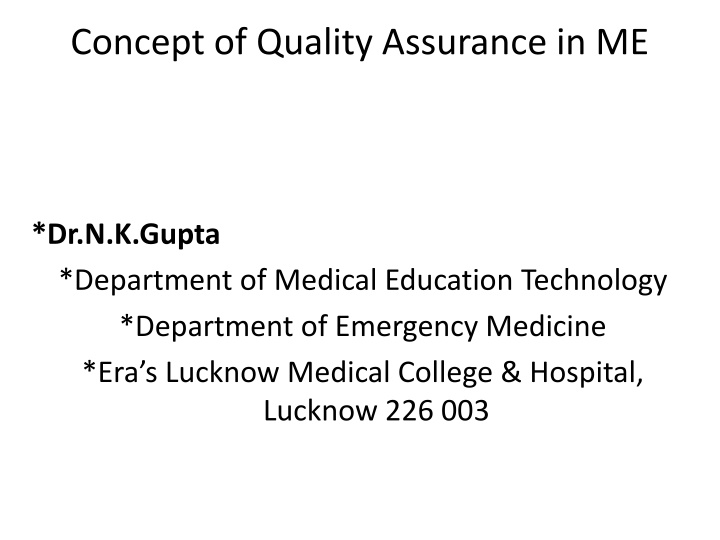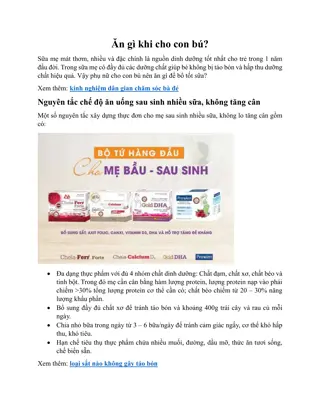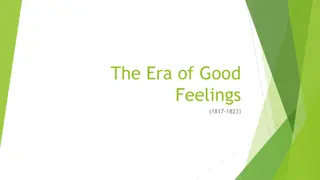
Quality Assurance in Medical Education: Ensuring Standards and Continuous Improvement
Quality assurance in medical education involves defining missions, setting learning objectives, assessing students, supporting staff, evaluating programs, and ensuring governance and administration. It focuses on maintaining and improving teaching, scholarship, research, and students' learning experience through credible processes that involve stakeholders and encourage innovation. The integrity and professionalism of the academic community are key to achieving quality outcomes.
Download Presentation

Please find below an Image/Link to download the presentation.
The content on the website is provided AS IS for your information and personal use only. It may not be sold, licensed, or shared on other websites without obtaining consent from the author. If you encounter any issues during the download, it is possible that the publisher has removed the file from their server.
You are allowed to download the files provided on this website for personal or commercial use, subject to the condition that they are used lawfully. All files are the property of their respective owners.
The content on the website is provided AS IS for your information and personal use only. It may not be sold, licensed, or shared on other websites without obtaining consent from the author.
E N D
Presentation Transcript
Concept of Quality Assurance in ME *Dr.N.K.Gupta *Department of Medical Education Technology *Department of Emergency Medicine *Era s Lucknow Medical College & Hospital, Lucknow 226 003
Quality Assurance *Target Audience Medical Faculty *Program 5thWorkshop ( as per MCI Requirement) *MCI Observer (Regional Center KGMU) Prof. Dr.Uma Singh
Quality Assurance Mission Medical schools need to define their overall mission & objectives & make these known major stakeholders, community & government. Medical schools then develop & implementing curricula appropriate to their mission.
Quality Assurance Learning Objectives Mission and Objectives Educational program Assessment of students Student selection and support Academic staff Educational resources Program evaluation Governance and administration Continuous renewal
Quality Assurance Definition Totality of systems, resources & information devoted to maintaining & improving the quality & standards of teaching, scholarship & research, & of students learning experience. Quality Assurance Agency in UK Higher Education
Quality Assurance ATTRIBUTES - Credible QA process Include all major stakeholders. Open to external public scrutiny. Conducted in a consultative & consensus- building fashion. Balance academic priorities with those of regulating authorities. Identify both strengths & weaknesses. Encourage innovation & re-orientation toward changing health needs.
Quality Assurance contd Means & authority to implement its conclusions. Monitor progress on an ongoing cycle of review. Focus on achievement of self-specified objectives. Encourage variety of methods of teaching & learning. Ensure choice of credible student assessment methods appropriate for teaching & learning methods chosen. Ensure adequate resources to deliver curriculum. Concerned with good outcomes.
Quality Assurance Most important - own internal Quality of medical education depends on interaction between teacher & student. Collective integrity & professionalism of academic community. Develops its own goals & objectives - relevant to local & national health care needs & methods to achieve goals. Conducts periodic reviews to assess extent to which goals are met within framework of guidelines, & whether methods of teaching & learning,facilities, & financial & human resources for delivery of curriculum support the goals. Invite external reviewers to assist in the review. FRAMEWORK FOR ESTABLISHING A QA SYSTEM 2 Parts -Internal & external QA process.
Quality Assurance FRAMEWORK FOR ESTABLISHING A QA SYSTEM External QA Through mechanisms such as accreditation, validation & audit. Confirm that medical school s responsibilities are being properly discharged. Methodological approaches -adopted to provide guarantees of quality. Independent agency - functions in continuous, transparent & open way. Includes in its quality process representatives - medical schools & profession, health care & registration authorities . In most countries processes of external agency incorporate medical school s own internal quality assurance processes.
Quality Assurance Teaching & learning methods Should be enjoyable & consistent with educational objectives. Clinical clerkships - principles of active student participation, problem solving & development of communication skills, + other educational strategies that promote Learner-centred learning, stimulate analytical skills & organization of knowledge, & foster life-long learning skills considerable educational merit. Learning in small groups - more expensive to deliver than large groups- strategies can be employed to achieve economies in other areas. Use of a computer - integral part of medical practice. supplement - acquire an understanding of medical informatics. Computer-assisted learning modules - some lectures replaced, & digital technology improved opportunities for practical teaching .
Quality Assurance MONITORING, EVALUATING & CHANGING CURRICULUM Mechanisms for monitoring & evaluating its curriculum. To be useful, relatively high rate of completion, & questionnaires must be carefully designed and evaluated. Mechanisms for feeding information back to those responsible for designing and teaching individual courses or course components. Students perceptions analysed. If appropriate, the component should be altered. There should be other pathways for student feedback as well.
Quality Assurance MONITORING, EVALUATING AND CHANGING CURRICULUM Evaluate its curriculum by examining pass rates in individual components, best method appropriateness & effectiveness - to examine quality of graduates. Follow-up mechanisms for feedback from hospitals(work as interns & residents & graduates themselves). Monitor & respond to community perceptions about deficiencies in their graduates. Identify forms of medical practice that their graduates appear reluctant to pursue, as this may reflect insufficient exposure to these areas during basic medical education & early stages of postgraduate training.
Quality Assurance Benefits of quality assurance by accreditation Benefits flow from feedback provided by external reviewers and report. Final responsibility for granting or withholding authorisation for award of a medical degree lies with national governments. Quality assurance mechanism also serves many useful purposes for its stakeholders - prospective students, employers of graduates of medical schools & ultimately, community that relies on medical school to produce safe, effective & caring doctors.
Quality Assurance Best practice in QA systems Universities - long tradition of academic autonomy to ensure that fundamental educational principles are not compromised by other interest groups, in professional programs such as medicine, community, profession & government all have legitimate interests in quality & orientation of graduates of program.
Quality Assurance Quality assurance in approving new medical courses The development of a new medical school is a complex undertaking. About the workforce implications of the new school, how it will be resourced, and the educational needs it will serve. Another decision that has to be made likely to meet standards ; commitment and capacity to manage .
Quality Assurance ETHICS Medical school must identify & incorporate in curriculum - behavioural sciences, social sciences, medical ethics & medical jurisprudence that enable effective communication, clinical decision making & ethical practices. Should be adapted to scientific developments in medicine, to changing demographic & cultural contexts & to health needs of society. Behavioural & social sciences & medical ethics should provide knowledge, concepts, methods, skills & attitudes necessary to understand socio-economic, demographic & cultural determinants of causes, distribution & consequences of health problems.
Quality Assurance TEACHER AND STUDENT FEEDBACK Both teacher and student feedback must be systematically sought, analysed & responded to. Quality development: Teachers & students should be actively involved in planning program evaluation & in using its results for program development. STUDENT PERFORMANCE Must be analysed in relation to curriculum & mission and objectives. Should be analysed in relation to student background, conditions & entrance qualifications, used to provide feedback to committees responsible selection, curriculum planning & student counselling. Include information about average study duration, scores, pass & failure rates at examinations, success & dropout rates, student reports about conditions in their courses, & time spent by students on areas of special interest.
Quality Assurance ACADEMIC LEADERSHIP Responsibilities of the academic leadership must be clearly stated. Should be evaluated at defined intervals with respect to achievement of mission & objectives. CONTINUOUS RENEWAL Must as a dynamic institution initiate procedures for regular reviewing & updating of its structure & functions & must rectify documented deficiencies. Exchange with Other Educational Institutions Quality Describe any activities directed towards regional and international co-operation with other medical schools.
Quality Assurance Any Questions?????????? Any suggestions Any suggestions Thank you Thank you





















